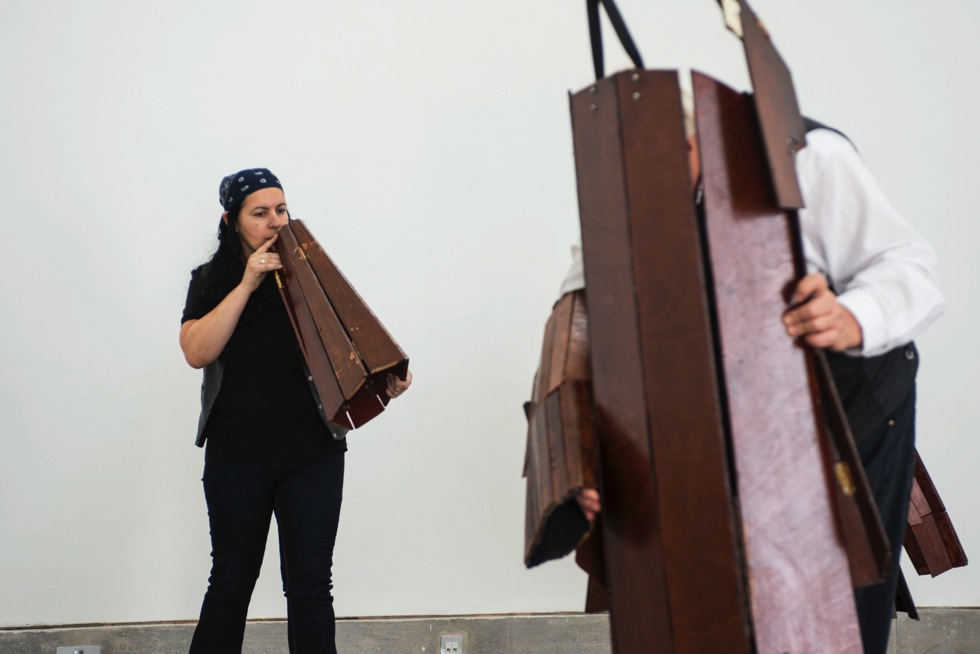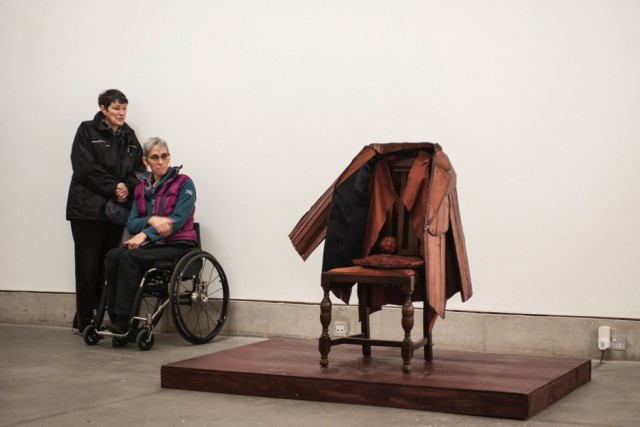Brian Catling’s Antix 2 — Reviewed

“He went to bed and bound his head with vinegar and brown paper…” C. James Fagan finds nursery rhymes, alchemy and transformation powering the heart of the Bluecoat’s Art of the Lived Experiment exhibition…
For a number of weeks now I’ve seen the pieces that form Brian Catling’s Antix 2 sculptural performance — itself part of DaDaFest’s Art of the Lived Experiment exhibition at the Bluecoat — as a series of immovable objects, immobile blocks of wood. Though at least two of the items in the room hold forms that my brain tells me should be soft and yielding.
In the gallery’s upstairs exhibition space, there are two ‘jackets’, either made from wood or cladded with wood, draped over two chairs. Like the chairs, they offer little in the way of change, yet I’m well aware that this apparently static room is mutable. That’s why I’m here to see this space change, enter a transformative process and live up to the thematic concept of the Art of Lived Experiment exhibition. Formed around the ancient practice of alchemy, it claims to address “the idea that both art and life are in a state of continual change and uncertainty. Both are subject to flux and transformation.”
Change enters quietly in the form of Brian Catling, whose first act is to take a long wooden pole, dip one end in vinegar, and then to start banging it against the gallery floor. The sound increases as it reverberates around the gallery space. A signal that the performance has begun, an overture for the main performance.
Replacing the pole, Catling approaches a bowl of vinegar placed upon a roll of brown paper. As he begins to strip pieces of brown paper away and soaks them in vinegar, something begins to nudge at the edge of my memory; didn’t Jack and Jill bind their wounds with these in the nursery rhyme?
As Catling wraps the primitive bandages around his head, I try to think about what’s unfolding in front of me. Maybe it’s too early to consider that, as this is still the opening of the performance. One thing I feel sure of is that these actions do have meaning; it is evident in Catling’s movements. As he removes the sodden mask and leaves it in a soggy lump on the floor, I’m feeling that any attempt to decode performance maybe futile.
Catling is now unfolding a large set of wooden slats which had previously been hanging from an antler. As it unfolds, it looks not unlike a dressing screen, one which Catling hides behind. It now looks less like a piece of furniture, more like a crude drawing of the human form. From behind, Catling begins to animate the object, and it comes to a shuffley, ungainly form of life.

It is surprising to see this once inert lump of wood moving in front of me, a creature animated by ritual and unsure of its purpose in its brief existence. Brief as it is, it is returned to its waiting place and Catling returns to the vinegar. This time, to tear a small vinegar-enriched sliver off and wrapping it around his tongue. He then takes a large swig of vinegar. It is unknown whether this is an act of purification or an extreme act of healing.
It could simply be the transition between one stage to another. Once the vinegar has been expelled, Catling removes one of the jackets off the chair then begins to move around the room, arm outstretched, as if searching for something with eyes closed. Like a psychic reading the room. After passing his hand over everyone gathered, he finds what he wants: he takes the arm of a woman and places her on the chair.
Covering her head in a shroud, he opens up her shirt and starts rooting around. First, he pulls out what looks like two rib bones, then a wooden heart. This seems to be a humane sacrifice, as once the item is removed, the subject returns to her original place in the audience.
The heart becomes his focus; it is placed gently onto a wooden pillow. Catling then shakes a tambourine above as if to coax it into life. If it ever had life. Finding these attempts fruitless, he takes the pillow and heart and places them carefully upon one of the chairs, making a reliquary of sorts.
Before giving up entirely, he takes the pole from the opening scene and taps it gently on the floor in front of the heart. As a signal for it to start beating.
Catling then returns to the brown paper, picking up the ribs from earlier and using them to cut an arc in the paper. Once torn away, this is shaped into a cone, which fits into a wooden cone which then becomes affixed around Catling’s head. He moves towards the back wall and begins to bang his head against it whilst gingerly trying to find the edge. This could be read in many ways; frustration at the failure of the ritual, or that the performance is coming to end, and this is a form of affirmation?
It is unknown, remaining unfixed outside Catling’s head as he continues to tap out a special code to the universe. Catling goes on to fix a branch to an extending pole which is then planted to form part of the Wooden Heart Reliquary.
There is no specific point I can refer to and say ‘the performance is about X’; Antix 2 is as much about the experience of the place as it is about the concepts that underpin it. Catling has utter confidence within his actions and this succeeds in pulling you into the performance. It is clear that ideas of ritual and transformation are part of its DNA, and it is this element of transformation that makes any form of conclusion difficult.
I leave the space knowing a transformation has been undertaken, yet that transformation is ambiguous and unclear. I know that ultimately the change will itself change overtime.
C. James Fagan
See Brian Catling’s Antix 2 performance at the Bluecoat, Liverpool on 8, 9 and 10 January 2015, 12-1pm and 2-3pm. Free, just drop in!
More on Catling on his website
“I Always Avoided Referring To Disability In My Work, Because I Was Afraid To Seem Pitiful”: The Transformation Of DaDaFest by Jade French
Images courtesy Jon Barraclough





